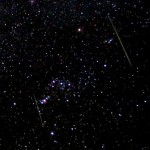The annual Geminid meteor shower has become one of the most reliable annual meteor showers. First observed over 150 years ago this is a interesting meteor shower. The parent body for the Geminids is not a comet, but rather the asteroid 3200 Phaethon. It is somewhat of a mystery how this mostly rocky body gives rise to the debris stream needed to generate a meteor shower.

While the 2013 Geminids are expected to just as numerous as usual, viewing will be hampered by a bright Moon in the sky. Full Moon occurs on the 16th, placing peak just a few days before full. This puts a big, bright Moon in the sky for much of the night. Certainly the brighter fireballs will be easily visible, but the dim meteors will be lost to the moonlight. A dedicated observer might make use of the small window of time between moonset at 5:24am and sunrise about 06:50am on the morning of the 14th.
Watching meteors requires no more equipment than your eyes and a dark sky, and can be enjoyable for just about anyone.

